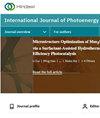ZnO/NiO Nanocomposite with Enhanced Photocatalytic H2 Production
IF 2.1
4区 工程技术
Q3 CHEMISTRY, PHYSICAL
引用次数: 0
Abstract
Inorganic photocatalytic materials exhibiting a highly efficient response to ultraviolet-visible light spectrum have become a subject of widespread global interest. They offer a substantial prospect for generating green energy and mitigating water pollution. Zinc oxide (ZnO), among various semiconductors, proves advantageous for water-splitting applications due to its elevated reactivity, chemical stability, and nontoxic nature. However, its efficacy as a photocatalyst is hindered by limited light absorption capacity and swift charge carrier recombination. To improve charge separation and enhance responsiveness to ultraviolet-visible light photocatalysis, the formation of a heterojunction with another suitable semiconductor is beneficial. Thus, we employed hydrothermal route for the synthesis of the samples, which is a high-pressure method. The formations of ZnO/NiO heterostructures were revealed by scanning electron microscopy, X-ray diffraction analysis, energy-dispersive X-ray spectroscopy, and Fourier transform infrared spectroscopy. The nanocomposites were discovered to have a substantially higher photocatalytic activity for the generation of H2. The H2 production rates show that ZnO (i.e., 168.91 molg-1 h-1) exhibits good H2 production rates as compared to NiO (i.e., 135.74 molg-1 h-1). The best production rates were observed for ZN-30 (i.e., 247.56 molg-1 h-1) which is 1.46 times greater than ZnO and 1.82 times greater than NiO. This enhanced photocatalytic activity for ZN-30 is because of the good electron-hole pair separation due to the formation of depletion layer, suppression of fast charge recombination, and overcoming resistance corrosion.具有增强型光催化制氢功能的氧化锌/氧化镍纳米复合材料
无机光催化材料对紫外-可见光光谱具有高效响应,已成为全球广泛关注的主题。它们为产生绿色能源和减轻水污染提供了广阔的前景。在各种半导体中,氧化锌(ZnO)因其较高的反应活性、化学稳定性和无毒性,在水分离应用中具有优势。然而,其作为光催化剂的功效却因有限的光吸收能力和快速的电荷载流子重组而受到阻碍。为了改善电荷分离,提高对紫外-可见光光催化的响应能力,与另一种合适的半导体形成异质结是有益的。因此,我们采用了高压水热法合成样品。扫描电子显微镜、X 射线衍射分析、能量色散 X 射线光谱和傅立叶变换红外光谱揭示了氧化锌/氧化镍异质结构的形成。研究发现,纳米复合材料在产生 H2 方面具有更高的光催化活性。H2 生成率表明,与 NiO(即 135.74 molg-1 h-1)相比,ZnO(即 168.91 molg-1 h-1)表现出良好的 H2 生成率。ZN-30 的生产率最高(即 247.56 molg-1 h-1),是 ZnO 的 1.46 倍,是 NiO 的 1.82 倍。ZN-30 的光催化活性之所以得到增强,是因为耗尽层的形成使电子-空穴对分离良好,抑制了快速电荷重组,并克服了电阻腐蚀。
本文章由计算机程序翻译,如有差异,请以英文原文为准。
求助全文
约1分钟内获得全文
求助全文
来源期刊
CiteScore
6.00
自引率
3.10%
发文量
128
审稿时长
3.6 months
期刊介绍:
International Journal of Photoenergy is a peer-reviewed, open access journal that publishes original research articles as well as review articles in all areas of photoenergy. The journal consolidates research activities in photochemistry and solar energy utilization into a single and unique forum for discussing and sharing knowledge.
The journal covers the following topics and applications:
- Photocatalysis
- Photostability and Toxicity of Drugs and UV-Photoprotection
- Solar Energy
- Artificial Light Harvesting Systems
- Photomedicine
- Photo Nanosystems
- Nano Tools for Solar Energy and Photochemistry
- Solar Chemistry
- Photochromism
- Organic Light-Emitting Diodes
- PV Systems
- Nano Structured Solar Cells

 求助内容:
求助内容: 应助结果提醒方式:
应助结果提醒方式:


